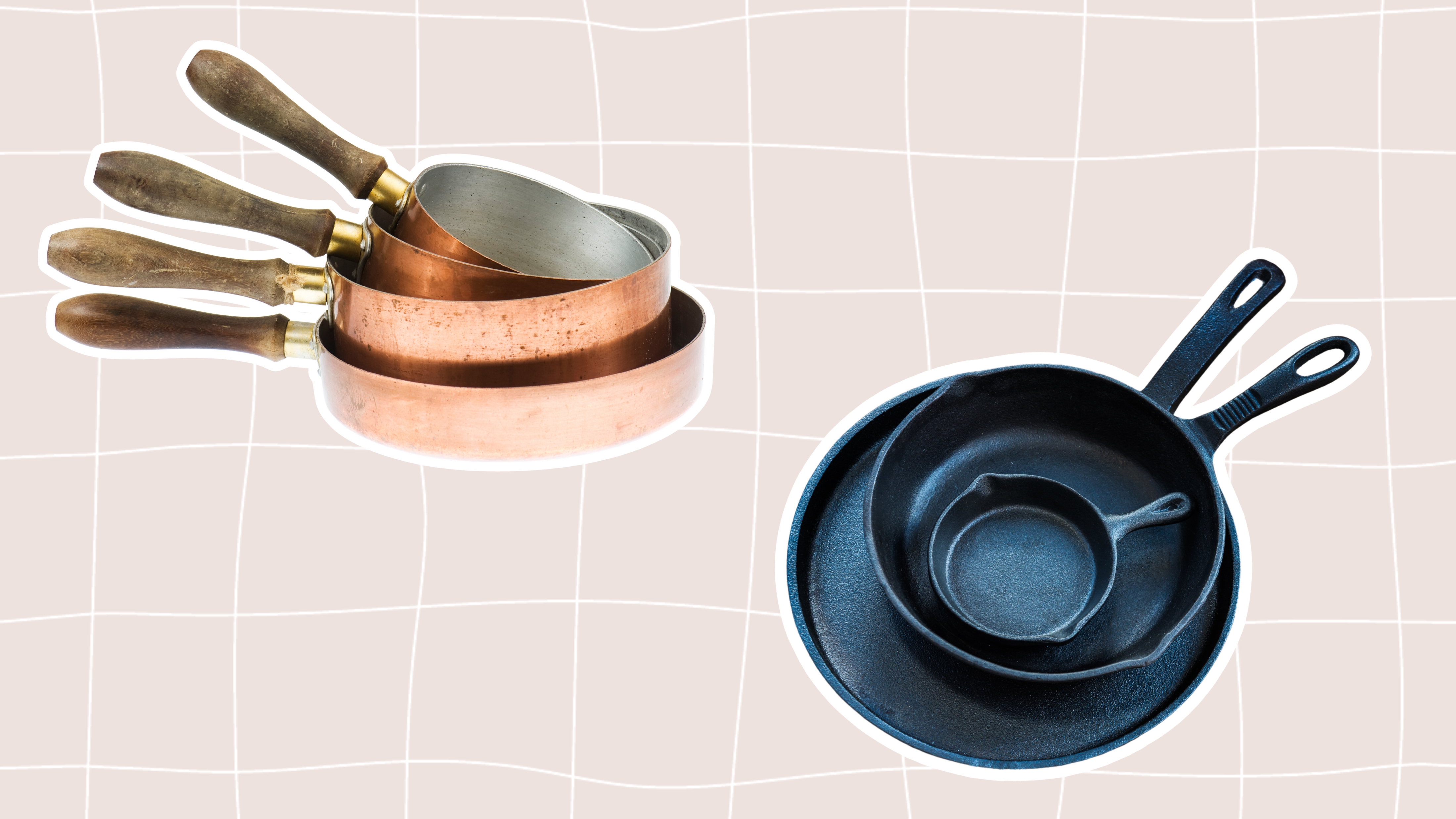Help! What's the best type of cookware?
Wtf is the difference?


Shopping for your first kitchen? You may be stuck in the aisles of Target, wondering wtf is the difference between all of these pans!
From tried-and-true cast iron skillets to the latest colorful-hued ceramic pans, cookware, just like fashion, goes through trendy cycles. However, using the best cookware for your recipe goes further than what’s in style.
It's important to understand which material is best for which job, so all that work you spent cooking dinner isn't a waste. Burning a precious dinner you spent time and money on is beyond tragic.
An encompassing look at all the cookware on the market, this is your guide to finding the best pieces you need in your kitchen cabinets. Bon appetit!
Cast Iron
Known as one of the most durable pans around, cast iron pans can last generations, be taken on camping trips, and can be used in fine dining restaurants. A staple of almost every serious cook (including grandmothers across the world), cast iron has been all the rage for centuries.
One of the best features of a cast iron pan is that the material causes it to absorb and distribute heat evenly, making it ideal for frying, sauteing, and baking. Extremely versatile, cast iron pans develop a natural non-stick surface that becomes seasoned by a natural patina that tends to add more flavor to foods.
Although cast iron pans could crack under an immense amount of heat, they will typically outlast other pans in your kitchen if properly cared for.
Get small space home decor ideas, celeb inspiration, DIY tips and more, straight to your inbox!
Stainless Steel
Stainless steel cookware tends to be pricey, and for good reason. This type of pan is used by great chefs in some of the best restaurants in the world.
Known for their ease of maintenance (some stainless steel is even dishwasher safe), they’re great for cooking up quick recipes or preparing elements for your main dish. Ideal for frying, boiling, and simmering, stainless steel pans are highly-durable.
Stainless steel itself has lower heat conductivity than other types of cookware but many stainless steel pans on the market feature other materials, such as copper, on the bottom of the pan for higher heat conductivity.
One of the key factors in cooking with stainless steel is to keep in mind that you may have to use more oil when cooking in order to prevent ingredients from sticking to the pan. Stainless steel is also one of the few types of cookware that can be 100% recyclable, making it a sustainable way to outfit your kitchen.
Ceramic
Lightweight, non-stick, and easy to use, ceramic pans are great for home cooks that may be intimidated by cast iron or stainless steel pans.
One of the highlights of a ceramic pan is that the ingredients cooked in these pans tend to retain their flavor, meaning ceramic pots are a great option for cooking homemade soups. Ceramic pans are also a great purchase for those who want to keep a minimalist kitchen. They can be used for many different types of cooking.
One downside is that, depending on your pan, the non-stick coating may degrade over time, making it less reliable for long-term use when compared to more expensive materials.
These pans are also almost always easy to clean, making them a great option for busy on-the-go home cooks.
Copper
Watch a Nancy Meyers film, the director known for comfy kitchen interiors, and you’ll likely spot a copper pot. More than being pleasing to the eye, copper pots have great heat retention and are used for serving meals that need to stay warmer for longer.
Copper is said to have natural antimicrobial properties that are potentially beneficial to keeping a clean kitchen. On top of that, copper pots are highly-durable and typically require less energy to use. The main drawback to owning copper pots is their price point — typically they are much more expensive than other types of pans.
Carbon Steel
Although carbon steel pans are typically lesser known, their popularity has increased in recent years. A staple in some European kitchens and restaurants, carbon steel pans are known for its impressive ability to distribute heat evenly.
Great for a variety of styles of cooking, including searing, sautéing, and pan frying, these pans begin their lives with a shiny silver coat that, over time, develops into a black patina.
Titanium
Titanium isn’t commonly found in the cookware aisles of your favorite department store. While titanium infused pans tend to look like stainless steel pans, they’re typically more lightweight and sometimes scratch proof, which can be great for repeated use.
However, the downsides of titanium cookware tend to outweigh the good. For instance, titanium pans are more expensive than stainless steel or copper, and they’re also not conducive to retaining heat.
They are commonly used in one type of cooking in particular — cooking while camping and backpacking. Known for being a workhorse, its lightweight material makes it a great option for using in the outdoors.
Glass
Typically, glass pans are used inside the oven. The materials ability to retain heat is one reason it will more evenly bake your brownies or casserole better than a metal pan. Great for baking especially, glass’ low heat conductivity allows certain dishes to cook more evenly and at a steady pace.
It’s also a great material to cook more acidic deserts (versus metal pans) as it’s non reactive with acid found in ingredients like oranges, lemons or berries. In recent years, glass has also been used because it is said to be less toxic than other materials, such as metal.
Although you typically won’t find glass pots on a stovetop, they are great for oven use and once you’re done, they’re also great for storing in the fridge.

Hello! I’m Kate Santos, a writer and photographer based in Los Angeles. In the design world, I got my start working as an Editorial Intern for Dwell magazine in San Francisco. Since then, I’ve written about design and architecture in many national magazines and online publications, including Playboy, Hunker, and The Culture Trip.
I grew up in a very old house in North Carolina and am still influenced by the rustic, charming, antique and aged elements of a home. Sustainability and longevity is extremely important to me and I believe learning to reuse materials or purchasing items you’ll love forever goes a long way. I also lean towards the Japanese philosophy of wabi-sabi when designing my own home, embracing the perfectly imperfect items I can find.